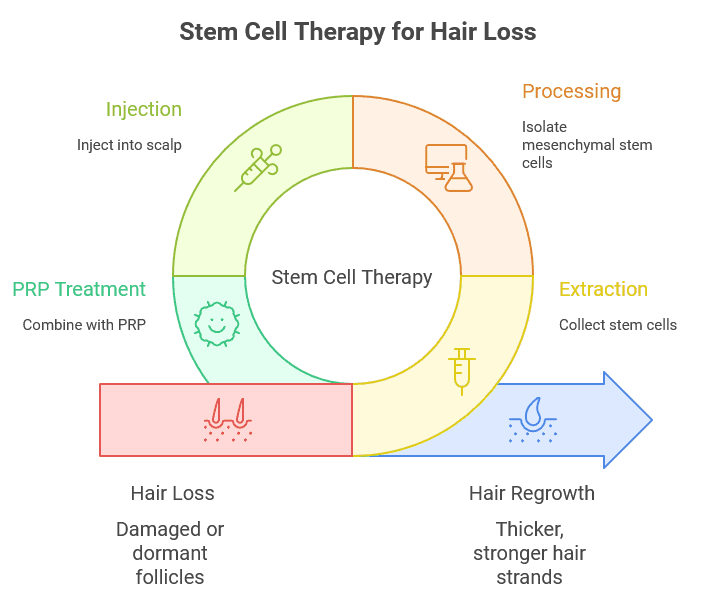There is an exciting new development in the world of hair loss treatments that has great potential— stem cell hair transplants. However, this is still an experimental procedure that has a long way to go before it is approved for use in clinics around the world.
For now, stem cells are primarily used as an effective additional treatment to speed up the healing process after a transplant. We will take a more detailed look at the science behind it, when it is used, and what the future holds.
How Stem Cell Therapy Works
The main goal of this procedure is to bring new life to damaged or dormant follicles and promote new growth. It starts by extracting the stem cells from a certain area of the patient’s body. The doctors may use punch biopsies to collect the required cells straight from the follicles, or use liposuction to extract adipose tissue (fat cells).
The samples are then processed to get mesenchymal stem cells, a generic form that hasn’t yet turned into any specialized cell and can, therefore, be injected into the scalp, where it will aid the function of the surrounding cells.
Once applied to the scalp, it may be combined with a platelet rich plasma (PRP) treatment to further promote growth. This procedure is approved by the Food and Drug Administration (FDA) and improves blood supply to the follicles, kickstarts the growth phase, and helps the area heal faster.

Is This Treatment Effective?
Injecting stem cells into an area can boost the function of all types of cells and help them heal. That’s why it has become such a popular form of regenerative medicine. It also releases a growth factor that regenerates damaged hair follicles and brings those stuck in the dormant phase back into the growth phase.
This all leads to a much denser look with thicker and stronger individual strands, but it will not affect the bald areas caused by male pattern baldness. If the thinning and receding hairline are genetic and not caused by external factors, you will need to look for a different treatment.
Stem Cell Therapy vs. Hair Transplant Surgery
A special form of transplant is being developed, where a small skin sample is used to create a stem cell suspension from which doctors can then produce a large number of cells. These can then be implanted in the bald areas of the scalp, eliminating the need for harvesting the donor area at the back of the head for thousands of grafts. However, this approach is still in its infancy, so for now, the classic FUE and DHI transplants are the most reliable ways to ensure hair regrowth. Stem cells can then be used to help the regeneration and promote faster growth.
Cost Comparison Between the Most Popular Treatments
To give you an idea of just how much money you will need to set aside for an effective hair treatment, we’ve prepared a list of the most effective, FDA approved options and their common price ranges.
Procedure | Typical Cost in Turkish Clinics | Pricing Basis |
FUE Hair Transplant | $1,800 – $4,200 | Per session, often all-inclusive package |
DHI Hair Transplant | $2,500 – $6,000 | Per session or per graft-based packages |
Stem Cell Therapy | $1,100 – $7,700 | Per treatment or as an add-on to transplant |
PRP Therapy | $80 – $240 typical; larger packages may cost $500–$1,500 | Per session |
Risks and Side Effects
The cells are harvested from the patient’s own body to prevent the immune system from rejecting and destroying them, so this is a fairly safe procedure. It is also minimally invasive, requiring a few small needle punctures.
However, there are some potential risks you have to consider, including bruising and scarring at the extraction site, and pain and swelling at the injection site. There is also always a small chance of infection, and the results may not be uniform or all that impressive unless combined with a transplant.
Looking Ahead: Will Stem Cells Replace Hair Transplants?
In the future, stem cell treatments may offer a less invasive way to achieve the same results, actually regenerating follicles in bald areas and causing new hair growth. If this can be achieved, patients would have access to a procedure that could be repeated as many times as needed throughout their lives. It would be especially useful for those with minimal grafts available in the donor area.
The main problem is that, so far, human cells haven’t been able to create entirely new follicles, only help existing ones get more blood flow and become stronger. That is why a hair transplant in Turkey is still the number one answer for hair thinning and balding.
FAQs
Is stem cell therapy better than a hair transplant?
While it is certainly promising, it still lags behind and can only be used as an added bonus after a transplant to help with the healing.
Are stem cell hair treatments FDA-approved?
No, the Food and Drug Administration hasn’t yet approved this type of procedure for hair restoration, only for certain serious medical issues.
What’s the best option if I’m losing hair right now?
In the early stages of hair loss, medications like Minoxidil and Finasteride or even natural oils like argan and rosemary can slow down the progression, but a hair transplant procedure is the only effective solution for more severe cases.

